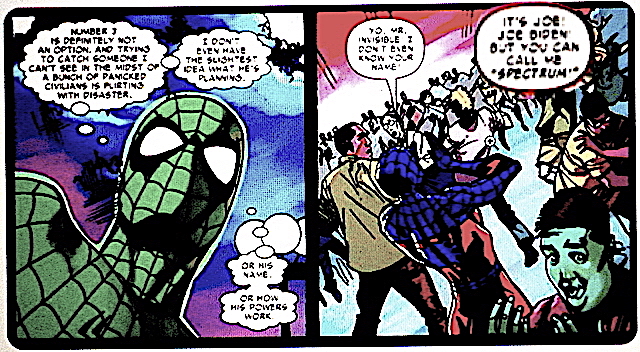Search
Recent comments
- between warmongers....
9 hours 32 min ago - protection....
9 hours 46 min ago - laws are for....
10 hours 25 min ago - the joys of war....
11 hours 2 sec ago - masters....
11 hours 17 min ago - 2023.....
13 hours 57 min ago - shakespearean.....
14 hours 39 min ago - hate.....
14 hours 47 min ago - des troupes....
15 hours 58 min ago - apologies....
17 hours 14 min ago
Democracy Links
Member's Off-site Blogs
the invisible villain…..
Spider-Man fans have been left stunned by the name of an obscure villain from the Marvel comic book series.
While many of Spider-Man’s nemeses are almost as well-known as he is – such as Doctor Octopus, Venom or Green Goblin – the minor fellon known as Spectrum has perhaps the most famous name of all.
As was recently pointed out in a viral tweet, Spectrum’s real name is in fact Joe Biden.
The character first appeared in Peter Parker No 1 back in 2010, at a time when the real-life Joe Biden was serving as US Vice President under Barack Obama.
READ MORE:
WE KNEW THAT:
https://yourdemocracy.net/drupal/node/40839
FREE JULIAN ASSANGE NOW @@@@@@@@@@
- By Gus Leonisky at 16 May 2022 - 9:44am
- Gus Leonisky's blog
- Login or register to post comments

700 dwarfs…….
The family-friendly, controversy-averse Walt Disney Co. has walked into the buzz saw of the American culture wars, version 2022.
In April, officials at Disney objected to a Florida law prohibiting instruction in sexual orientation and gender identity in kindergarten through third grade. Florida Gov. Ron DeSantis responded by signing a bill revoking Disney’s self-governing status, a unique arrangement in which the company operated like an independent fiefdom within the state.
Traditionally, the custodians of one of Hollywood’s most reliable cash machines have been careful to sidestep political minefields that might remind customers of a realm outside the Magic Kingdom. Better to wallow with Scrooge McDuck in the Money Bin than be caught in the crosshairs of Fox News chyrons.
Only once before has the Disney brand gotten so entangled in a public relations briar patch – in 1941, when the original iteration of the company was confronted by an internal revolt that pitted the founding visionary against his pen-and-ink scriveners.
The characters in the showdown were as colorful as any drawn on the studio’s animation cels: union activists, gangsters, communists and anti-communists, and, not least, Walt Disney himself, who, dropping his avuncular persona, played a long game of political hardball and slow-burn payback.
Workers Grumble as Disney’s Star Soars
Even then, Walt Disney inspired a special kind of awe around Hollywood.
Billy Wilkerson, editor of The Hollywood Reporter, declared Disney “the only real genius in this business” in the Dec. 17, 1937, issue of the periodical.
Disney was hailed as the father of the first sound cartoon, “Steamboat Willie” (1928); the first Technicolor cartoon, “Flowers and Trees” (1932); and the first feature-length cartoon, “Snow White and the Seven Dwarfs” (1937).
“Snow White” marked the beginning of the extraordinary creative streak – “Pinocchio” and “Fantasia” in 1940, “Dumbo” the following year and 1942’s “Bambi” – on which the Disney mythos would be built forever.
In 1940, Disney plowed the profits from “Snow White” into a state-of-the-art animation studio in Burbank, California, where the comfort of his workers, so he said, was a high priority.
“One of Walt Disney’s greatest wishes has always been that his employees could work in ideal surroundings,” read an advertisement in the Oct. 10, 1940, issue of The Hollywood Reporter. “The dean of animated cartoons realizes that a happy personnel turns out the best work.”
But even by the standards of exploitative Hollywood shop floors, Disney animators were overworked and underpaid. Forced to hunch over a drawing board for 10 hours a day, they had no desire to whistle while they worked. Instead, they wanted a strong union to negotiate on their behalf. Disney didn’t want any of it.
The animators opted to be represented by the confrontational Screen Cartoonists Guild rather than the pro-management “company union,” the American Society of Screen Cartoonists.
“Disney cartoonists make less than house painters,” charged the guild. “The girls are the lowest paid in the entire cartoon field. They earn from $16 to $20 a week, with very few earning as high as $22.50.” The guild demanded a 40-hour, five-day work week, severance pay, paid vacation and a minimum wage scale ranging from $18 a week for apprentices to $250 for cartoon directors.
To go nose-to-nose with Disney in the negotiations, the Screen Cartoonists Guild chose Herbert Sorrellof the Motion Picture Painters, Local 644, a longtime thorn in the side of studio management.
Sorrell was a broad-shouldered union man of the old-school variety. A former heavyweight prize fighter, he was not afraid to mix it up on the picket line with cops and strikebreakers.
Sorrell’s footwork in the boxing ring – not to mention the brass knuckles he carried – came in handy. In the 1930s, labor organizing in Hollywood could be more hazardous than stunt work. Many studio heads had already cut sweetheart deals with the mobbed-up trade unions, notably the International Alliance of Theatrical and Stage Employees, run by a Chicago-schooled gangster named Willie Bioff.
Animators Put Down Their Pens
On May 28, 1941, the Screen Cartoonists Guild called a strike, and hundreds of animators walked out on Disney.
Brazenly violating Disney’s copyright, the strikers repurposed Disney characters into pro-union spokesmen and paraded outside theaters playing Disney films.
“There are no strings on me!” exclaimed Pinocchio in one placard. The slogans were as clever as the visuals: “Snow White and 700 Dwarfs,” “3 Years College, 2 Years Art School, 5 Years Animation Equals 1 Hamburger Stand” and “Are We Mice or Men?”
Disney was enraged.
READ MORE:
https://consortiumnews.com/2022/05/13/disney-not-in-this-much-trouble-since-1941/
READ FROM TOP.
FREE JULIAN ASSANGE NOW..............